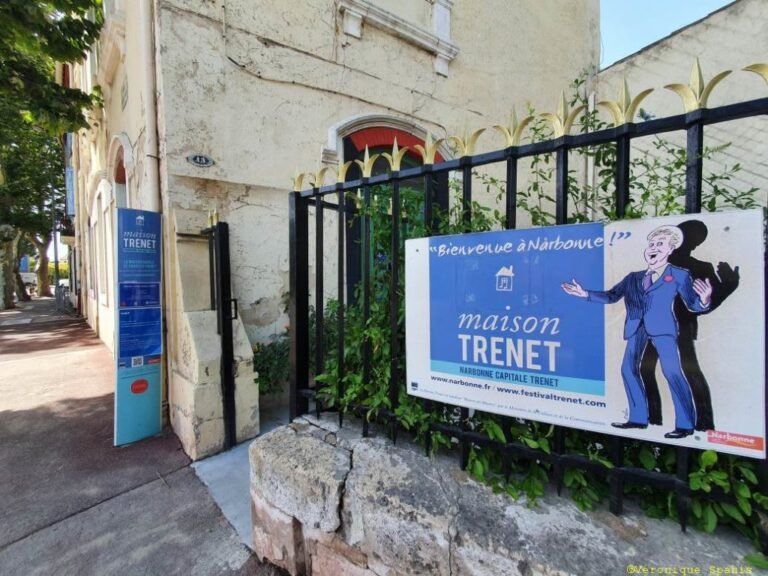Charles Trenet's Birthplace in Narbonne: A Journey to the Heart of the "Singing Fool's" Legacy
In the heart of Narbonne, a city steeped in history and the cradle of Gallo-Roman civilization in Gaul, stands a modest residence with green shutters that was the birthplace of one of the greatest poet-singers of the French-speaking world. The birthplace of Charles Trenet, located at 13 avenue Charles Trenet (formerly rue Anatole France), today constitutes a veritable sanctuary dedicated to the memory of the "Singing Fool." This bourgeois residence from the beginning of the 20th century, transformed into a museum since November 2000, offers visitors a unique immersion into the intimate world of the artist who knew how to sing like no other the "Douce France" and the Mediterranean art of living. More than just a place of memory, this house testifies to the deep roots of Charles Trenet in his hometown, an inexhaustible source of inspiration that nourished his work during his nearly seventy-year career.
Summary

Narbonne, Historic Setting and Source of Inspiration
A Thousand-Year-Old City with Exceptional Heritage
Narbonne, formerly Narbo Martius , the first Roman colony founded outside Italy in 118 BC, provides an exceptional historical setting for the birth and childhood of Charles Trenet . This city, which was the capital of the Roman province of Narbonne Gaul, today preserves prestigious testimonies of its ancient and medieval past. The Canal de la Robine , a UNESCO World Heritage Site, majestically crosses the city, connecting the Canal du Midi to the Mediterranean . This historic waterway, which follows the ancient bed of the Aude, which the Romans already traveled, perfectly symbolizes the maritime and fluvial identity of Narbonne which so inspired the young Charles.
Narbonne's architectural heritage, with its Archbishops' Palace , its unfinished Gothic Saint-Just-et-Saint-Pasteur cathedral, and the remains of the Via Domitia visible in the Town Hall Square, constitutes a grandiose setting that marked the imagination of the child prodigy . This rich heritage, harmoniously blending ancient remains and medieval architecture, forged Trenet's artistic sensibility, nourished from a very young age by this omnipresent beauty.
The Imprint of the Mediterranean and Languedoc
The exceptional geographical environment of Narbonne, at the crossroads of Mediterranean and Languedoc influences, profoundly marked the work of Charles Trenet. Located near the sea, rocked by the tramontane winds, the city offered the young Charles an ideal setting to develop his creativity . The ponds of Bages-Sigean, the beaches of Gruissan and Port-la-Nouvelle, accessible by the Robine canal, constituted as many playgrounds and discoveries which would later fuel his most famous songs, notably "La Mer" composed in 1943 .
The House with Green Shutters: Cradle of a Musical Genius
A Family Home Full of Memories
On May 18, 1913, a Sunday afternoon, Louis Charles Augustin Georges Trenet, better known as Charles Trenet, was born in this bourgeois house . This house, which he affectionately nicknamed "this old shack full of memories and nostalgia" , belonged to the maternal Caussat family . His maternal grandfather, Augustin Caussat, was a cooper and timber merchant, professions which testify to the artisanal and commercial roots of the family in the Narbonne economic fabric .
Charles Trenet's complex family structure, marked by his parents' separation in 1920, partly explains his deep attachment to his maternal home. Raised alternately by his grandparents Caussat and his aunt Émilie, Charles found in this house with green shutters a haven of peace and stability . It was in this provincial bourgeois atmosphere, punctuated by music (his mother Marie-Louise played the piano, his father Lucien the guitar), that the precocious talent of the future singer flourished.
A Conducive Musical and Artistic Environment
The family atmosphere of the Trenet household was particularly favorable to the blossoming of artistic talent. The presence of musical instruments, family musical evenings, and the cultural atmosphere of this enlightened provincial bourgeoisie shaped the sensitivity of the young Charles . The proximity of the railway, visible from the windows of the house, already fueled the imagination of the boy who spent hours watching the trains go by, dreaming of travel and distant horizons .
This house was also the setting for Charles's first poetic experiments. From the age of 13, he composed his first poems and sketched out his future songs there . The hushed atmosphere of this provincial residence, with its wicker furniture, period trinkets and bourgeois furnishings, constitutes the ideal setting for the blossoming of this nascent creativity that would mark all his future work.
The Awakening of an Exceptional Artistic Vocation
The First Inspirations of Narbonne
It was in this house that Charles Trenet drew his very first inspirations, those which would indelibly mark his future work. The child observed with fascination the spectacle of the street, the comings and goings on the avenue, the passage of the trains which took him by imagination to exotic destinations . This capacity for wonder, this faculty of transforming the everyday into poetry, found in the Narbonne environment a particularly fertile ground.
Walks with his grandmother at the Halles de Narbonne , crossings of the Canal de la Robine, strolls on the Passerelle des Barques , all these moments of daily life in Narbonne nourished the imagination of the future poet . The architectural richness of the city, with its Gothic monuments and Roman remains, offered the young Charles a grandiose setting that stimulated his budding creativity. These childhood impressions would later resurface in his most personal songs, notably "Narbonne, mon amie" where he tenderly evokes these childhood memories .
A Family of Artists and Music Lovers
Charles Trenet's family environment was particularly conducive to artistic development. His father Lucien, a notary but also an accomplished violinist and guitarist, his mother Marie-Louise, a pianist, and his brother Antoine, a future cymbalist, created a permanent musical atmosphere in the home . This "musical family" , to borrow the title of one of his later songs, provided the young Charles with the musical foundations that would later enable him to compose his own melodies.
The influence of his mother, Marie-Louise Caussat-Trenet, was particularly decisive. This cultured woman, from the Narbonne bourgeoisie, passed on to her son a taste for the arts and literature . Despite family upheavals (she left home in 1917 to follow Benno Vigny, a screenwriter and man of culture), she remained a tutelary figure for Charles, who dedicated several of his songs to her, notably "Maman chérie" .
Discover La Maison Gustave
Discover La Villa Ambrosia
An Immersive Scenography in the Service of Memory
A Unique Museum Tour
Since its opening to the public in November 2000, the birthplace of Charles Trenet has offered a particularly successful audiovisual and interactive scenography . Designed by Jacques Pessis and Marc Azéma, this staging respects the authenticity of the place while offering visitors a unique immersive experience. Each floor of the house tells the story of a different period in the artist's life, from his birth to his international recognition.
The ground floor presents the family environment with the living room of a family of musicians , decorated with the piano of Charles Trenet and numerous drawings by Cabu, a great admirer of the artist . Visitors also discover the family tree and personal memorabilia that testify to the Narbonne roots of the Trenets. This presentation allows us to understand the importance of the Languedoc terroir and Mediterranean culture in the singer's artistic training.
Archival Documents and Personal Memories
The wealth of documentation in the house is impressive in its diversity and authenticity. The archival documents on display include previously unseen family photographs, handwritten scores, personal letters, and accounts from contemporaries . These elements allow us to precisely trace the stages of Charles Trenet's artistic training and to measure the decisive influence of his Narbonne environment.
The personal memorabilia on display in the house create a particularly moving atmosphere of intimacy. The period wicker furniture from the childhood bedroom, everyday objects, and family photographs help to recreate the atmosphere of this provincial bourgeoisie at the beginning of the 20th century . This authenticity allows visitors to better understand the singer's sources of inspiration and the importance of his Narbonne roots in his work.
An Interactive and Musical Experience
One of the main attractions of the visit is its interactive features, which allow for a true immersion in Trenet's musical universe. The interactive screens offer the opportunity to view exceptional video archives, including performances of his greatest hits such as "La Mer" and "Y'a de la joie" . These documents allow us to measure the singer's artistic evolution and his extraordinary longevity.
A highlight of the tour is the karaoke "Boum , "Y'a de la joie," and "Le soleil et la lune ," in the very atmosphere where these songs were conceived . This fun activity allows visitors to better understand the popular and accessible dimension of Trenet's work, while creating a strong emotional connection with the artist.
Artistic Heritage: A Monumental Work Born in Narbonne
An Exceptional Repertoire of More Than a Thousand Songs
Charles Trenet's exceptionally rich oeuvre includes nearly a thousand songs that bear witness to his creative genius and extraordinary productivity . This titanic output, spanning more than seventy years of his career, draws its roots largely from the Narbonne environment of his childhood. The recurring themes of his compositions—nostalgia for the land, love of nature , celebration of provincial France—are rooted in the impressions and emotions of his early years spent in the house with the green shutters.
Among his timeless masterpieces , several bear the direct imprint of his Narbonne origins. "Douce France" (1943) is a hymn to the provincial France he knew in his childhood, while "La Mer" (1945), composed on a train between Perpignan and Montpellier, evokes the Mediterranean landscapes of his youth . "Y'a d'la joie" (1937), written during his military service, expresses the Mediterranean joie de vivre that so well characterizes the Narbonne art of living.
The Influence of the Languedoc Terroir
An analysis of Charles Trenet's work reveals the profound and lasting influence of his native land. References to the tramontane, the Languedoc wind that blows 270 days a year in Narbonne, run through his compositions . The evocation of Mediterranean landscapes, fishing ports, canals, and ponds testifies to the indelible imprint left by the geographical environment of his hometown.
This influence is also evident in the rhythm and melody of his songs, marked by a certain carefree attitude and a typically southern joie de vivre. The "troubadour swing" he developed in the 1930s has its roots in the Languedoc musical tradition, enriched by the jazz influences he discovered in Paris. This original synthesis of regional tradition and musical modernity makes Charles Trenet a unique artist in the landscape of French song.
Practical Information and Visiting Tips
Access Conditions and Opening Hours
The birthplace of Charles Trenet, located at 13 Avenue Charles Trenet in Narbonne, is easily accessible from the historic city center . Opening hours vary according to the seasons: from June to September, the house is open every day from 10 a.m. to 6 p.m., while in winter (November to March), it welcomes visitors every day except Tuesday from 10 a.m. to 12:45 p.m. and from 2 p.m. to 5 p.m.
The entrance fee is particularly affordable, at €5 for adults . The house also offers a Pass Monumentale Narbonne, valid for one year, which allows you to visit all of the city's heritage sites. For reasons of security and comfort, the capacity is limited to a maximum of 18 people per visit , which guarantees an intimate and privileged experience.
Services and Facilities
The welcome at Charles Trenet's birthplace is distinguished by its international dimension, with staff able to guide visitors in French, English, Spanish and Italian . This linguistic openness testifies to the artist's international influence and the tourist attraction that this place of memory represents for foreign visitors.
The house has a gift shop offering a selection of memorabilia, books, and recordings related to Charles Trenet. Accepted payment methods include credit cards, checks, cash, and bank transfers. The recommended visit is approximately one hour, allowing for a comfortable visit to all three floors.
The birthplace of Charles Trenet is a perfect addition to a Narbonne heritage discovery tour. Its proximity to the city's other major sites (Archbishops' Palace, Cathedral , Canal de la Robine ) makes it ideal for a full day of cultural visits. Lovers of French song and those passionate about cultural history will find this house an ideal complement to their discovery of Narbonne, a city of art and history that has preserved and promoted the legacy of its most illustrious son.
This residence with green shutters continues today to perpetuate the memory of the "Singing Madman", testifying to Charles Trenet's unwavering attachment to his hometown, which he evoked with these tender words: "My other houses belong to me, but I belong to the one in Narbonne". A testimony that perfectly sums up the importance of this exceptional place in understanding the work and personality of one of the greatest French artists of the 20th century.
Retain
- Charles Trenet's birthplace in Narbonne is a place steeped in emotion and memories, offering an immersion into the childhood and life of one of France's greatest artists.
- Located at 13 avenue Charles Trenet , the residence retains its authenticity, with an interactive scenographic route punctuating the visit.
- Visitors can discover the family atmosphere, period furniture, rare archives, personal objects and even sing along to the greatest hits of the "Singing Madman".
- Trenet's universe, marked by poetry and joie de vivre, finds its roots in the Mediterranean and Narbonne atmosphere.
- This museum is a must-see for lovers of French song and anyone who wants to better understand the inspiration behind masterpieces such as “La Mer” or “Douce France” .
- The tour is accessible to all, in several languages, for a friendly and authentic experience in Narbonne's heritage.


